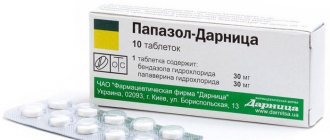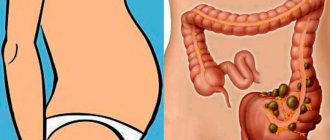A healthy child's stool is brown. Their hue is given by the pigment stercobilin, which is the end product of bilirubin metabolism. With the development of certain pathologies, the substance may be produced in insufficient quantities.
White poop can be a sign of disturbances in the gastrointestinal tract, bile stagnation, pancreatitis and other diseases. But don't panic right away, because there are other conditions that affect the color of feces and do not require treatment.
Physiological causes of white stool in children
The color and consistency of stool depend on the age of the baby. In newborns, the stool is black and viscous; after a few days it begins to lighten. The presence of white or yellowish spots in a baby's stool is considered normal. There are many reasons for the appearance of white feces. If the child does not have diarrhea, fever or other warning signs, then there is no need to worry.
A change in stool color could occur under the influence of physiological factors:
- introduction of complementary foods;
- taking medications;
- violations of personal hygiene;
- insufficient water consumption;
- teething;
- climate change;
- changes in daily routine.
After the influence of such factors stops, the stool acquires a natural color.
Nutrition
In children who are breastfed, the color of stool changes depending on the mother's diet. Unusual coloring of feces is observed within 24 hours, after which they acquire a normal shade. Also, light-colored feces are formed in artificial babies who eat dry formula.
White poop in a child can also be observed after the introduction of complementary foods, which is also considered a variant of the norm. The reason for this phenomenon is the immaturity of the baby’s digestive system. Gradually, the condition will normalize, and the stool will acquire a darker shade.
If the problem is detected in a child after 2 years, you need to pay attention to what the baby ate the day before. If digestion is not impaired, there are no symptoms of the inflammatory process, then the cause is most likely in the excessive consumption of certain foods, for example, dairy.
Effect of medications
In some cases, white feces in a child may be a variant of the norm.
With long-term treatment with antibacterial drugs, the color of stool may also change. This is a sign of dysbiosis, so the child will need treatment that will help restore the intestinal microflora.
White poop may also appear in a child after using other medications:
- antipyretics;
- anti-inflammatory;
- antiepileptic.
If you notice a violation, you need to seek advice from a specialist who prescribed medication. Usually, after stopping the drug, the condition returns to normal.
Diseases with symptoms of “white feces”
Let's look at why white feces may still be released. If stool changes are not related to nutrition or treatment, the disorder is due to gastrointestinal dysfunction. Defecation is affected by problems of the biliary system, intestines and liver. Thus, white stool can be a symptom of various diseases.
- Rotavirus infection. The clarified stool is released in the form of diarrhea, the child vomits and the temperature rises. At first, the stool turns yellow, but on the 2nd day it resembles clay. Additionally, a picture of acute respiratory infections is drawn - headache, discomfort in the throat, runny nose, cough, poor appetite.
- Dysbacteriosis. The white stool liquefies, and green mucous inclusions are visible in the masses. The stool is foamy and foul-smelling. The child complains of abdominal pain, often farts, and itches due to skin rashes.
- Pancreatitis. The inflammatory process in the pancreas makes itself felt not only by whitish feces, but also by pain near the navel or in the abdomen on the right. Nausea, vomiting, thirst, temperature fluctuations require the attention of parents and consultation with a gastroenterologist.
- Whipple's disease is a rare pathology in children. It manifests itself as an increase in stool frequency up to 10 p.m. per day, excretion of light gray feces, iron deficiency anemia. The child's lymph nodes become inflamed and the temperature rises.
- Hepatitis. A dangerous disease will be diagnosed if for several days in a row the bowel movements are light gray in color and the urine becomes too dark. Yellowness of the skin will appear later.
Pathological causes, diseases
Changes in the color of stool in children are not always harmless. In some cases, this is a sign of serious problems in the body. At the same time, the baby’s general condition suffers, and other unpleasant symptoms arise that cannot be ignored.
Rotavirus infection in children
Changes in the color of stool can occur with rotavirus infection. The pathology is characterized by severe nausea, vomiting, diarrhea, acute pain in the intestines, and increased body temperature.
The child may also suffer from other manifestations:
- increased sweating;
- headache;
- respiratory symptoms (cough, runny nose, sore throat).
Fecal masses with this pathology can become clay-like or liquid, foamy, they lighten or acquire a grayish tint. Such changes are noted in the first days after infection or as a reaction to taking medications used to treat the disease.
Dysbacteriosis
A common cause of discolored stool in childhood is dysbacteriosis. In infants, the intestinal microflora is too vulnerable and susceptible to the negative effects of bacteria that upset the natural balance.
The development of the disease can be triggered by pathologies suffered by the expectant mother during pregnancy, the use of antibiotics by the child, and the nutritional habits of the woman and baby. At the same time, the feces acquire a pungent odor and become lighter in color.
In addition, the pathology is accompanied by:
- stool disorders. Diarrhea may alternate with constipation;
- abdominal pain;
- bloating;
- nausea, heartburn.
Pancreatitis
White poop in a child may be a sign of pancreatitis. In childhood, inflammation of the pancreas is rare; the pathology can be caused by medications or poor nutrition, which creates an increased burden on the child’s underdeveloped internal organs.
The baby's stool becomes white and watery, and severe pain occurs in the upper abdomen. The disease is also accompanied by nausea and vomiting, temperature fluctuations, a constant feeling of thirst, and diarrhea.
Hepatitis
Children aged 3-7 years are more at risk of developing hepatitis. You can become infected through food, drinks, and toys. The infection can also enter the body through airborne droplets.
Children may develop hepatitis B, which has a hidden course. Sometimes six months pass before the first symptoms appear. Then the feces lighten, and the urine becomes darker and acquires a pungent odor, and yellowing of the skin is noted.
In addition, the child loses his appetite, sleeps poorly, and his general condition is impaired. Possible fever, nausea and vomiting.
Discoloration of stool is also observed with hepatitis A, which is accompanied by the same symptoms. If you notice warning signs, you should immediately contact a doctor.
Steatorrhea
The cause of steatorrhea is excess fat in the body. The stool becomes oily, its color changes to grayish or white, and blood may appear.
Children also suffer from other symptoms:
- frequent urge to go to the toilet, accompanied by pain;
- cough, runny nose;
- appetite disorders;
- deterioration of general health.
Gallbladder diseases
Bile is removed from the body naturally. It contains a pigment that colors excrement. Some gallbladder diseases affect the color of stool.
When an organ is twisted, bent, or obstructed, it becomes lighter. A patient with such pathologies requires urgent treatment.
Whipple's disease
This is a rare disease that most often occurs between the ages of 3 and 4 years. In this case, the infection affects the gastrointestinal tract, causing the appearance of liquid, foamy feces with a pungent odor and a light gray color.
Evacuations occur more than 10 times a day, in addition, the temperature rises, cramps and bloating occur, the lymph nodes become inflamed and iron deficiency anemia develops.
Treatment
First aid
Prolonged diarrhea can lead to dehydration of the body, which leads to dangerous complications and even death. If you have white or light-colored diarrhea that does not go away for more than 2 days, seek immediate medical attention.
To alleviate the condition caused by disruption of the gastrointestinal tract, you can give him activated carbon (at the rate of 1 tablet of the drug per 10 kg of weight) or Smecta, which protect the digestive tract from further exposure to irritating factors and adsorb harmful agents.
It is imperative to maintain a drinking regime.
To avoid dehydration of the child's body, it is necessary to give the baby warm water (not carbonated!) every time after a bowel movement or vomiting.
You should also limit the child’s food intake and exclude fatty, fried foods, raw vegetables, and juices from the diet.
Every 2 hours, the child should be given a little rice water, which has a “fixing” effect, fennel tea or chamomile.
Levomycetin, which is acceptable for adults to take for diarrhea, is prohibited for children without a doctor’s recommendation!
In what cases is self-medication unacceptable and the help of doctors is necessary?
You should consult a specialist if, along with diarrhea, your child experiences:
- darkening of urine;
- the presence of mucus or blood in light diarrhea;
- abdominal pain;
- repeated vomiting, nausea;
- temperature increase;
- weakness, drowsiness;
- unquenchable thirst.
Consultation with a specialist is required if the frequency of bowel movements exceeds 10 times a day or lasts longer than 2 days.
How to determine dehydration and what to do?
- moderate degree of dehydration - thirst, anxiety and irritability, severe cloudiness of urine, dry skin;
- severe degree - confusion, lack of urination, cold hands and feet, tachycardia, pale mucous membranes and skin, decreased blood pressure.
Severe dehydration develops rapidly and, without emergency treatment, can be fatal.
To prevent dehydration, the child needs to take a saline solution, which is prepared at home (1 tsp x 1 liter of clean water) or purchased at a pharmacy (Regidron, Citroglucosolan).
White feces in the shape of worms
If a child has stool with white streaks, he may have colitis or dysbacteriosis. To confirm the diagnosis, you will need to consult a gastroenterologist.
White worms also appear in feces due to helminthiasis. In addition, the child’s sleep and appetite are disturbed, weight loss occurs, constipation or diarrhea occurs, and a rash appears on the skin.
If you suspect the presence of worms, you must contact a parasitologist, get tested and begin treatment under the supervision of a doctor.
When should you see a doctor? Diagnostics
White poop in a child is not always a sign of problems in the body. If stool of an unusual color appears, you need to observe the child for 2-3 days. If the color of the stool becomes normal, then there is no need to worry. If the situation has not changed and other warning signs appear, you should consult a doctor.
The following symptoms may indicate the presence of dangerous diseases:
- pain and severe bloating;
- violation of the passage of gases;
- nausea and vomiting;
- yellowing of the sclera of the eyes and skin;
- increased body temperature;
- lethargy, fatigue, loss of appetite;
- dehydration. This is a very dangerous sign. In infants, the fontanelle sinks and weight decreases. In older children, dry lips and a decrease in the number of urinations are observed;
- change in urine color.
Even if at least one dangerous sign appears, you must urgently visit a doctor. Severe pathologies in childhood are characterized by rapid development; it is important to begin treatment at an early stage of the disease.
In order to establish the cause of the disorder, the doctor will recommend urine and stool tests and refer the little patient for additional studies:
- X-ray of the intestines;
- clinical and biochemical blood tests;
- ultrasound examination of the abdominal organs;
- endoscopy, colonoscopy.
To clarify the diagnosis, you may need to consult a gastroenterologist, immunologist, endocrinologist or infectious disease specialist.
What should parents be wary of?

If a child is voiding colorless masses, parents should look for additional abnormalities:
- temperature;
- child weight loss;
- lack of appetite;
- severe bloating;
- changed color of urine;
- baby's complaints of abdominal pain;
- yellowing of the skin and eye sclera.
The combination of colorless feces with any of the listed conditions indicates the need to call an ambulance. Serious diseases such as pancreatitis, hepatitis, and biliary dyskinesia occur with such disorders.
Treatment methods for various diseases
The course of therapy is selected individually, depending on what caused the disorder.
Features of the treatment of pathologies that provoke stool discoloration:
| Disease | Features of therapy | Drugs used |
| Pancreatitis | The goal of treatment is to ensure peace, prevent damage to the pancreas, and eliminate the signs and cause of the pathology. The patient must adhere to a diet for 1-3 days. Specialists suction the stomach contents to prevent enzyme activation. When the pain decreases, you are allowed to eat boiled or steamed food, but without salt. The child should eat fractional liquid or semi-liquid meals. At the same time, medications are prescribed. | The patient is recommended to take enzyme preparations (Pancreatin, Mezim). It is also necessary to use:
In the case of a purulent bacterial process, antibacterial drugs are prescribed. |
| Dysbacteriosis | Treatment of the disease is complex. The patient is prescribed dietary nutrition and medications. The child's diet should contain products with bifidobacteria and lactobacilli. Drinking milk is prohibited, but you can replace it with yoghurt, kefir, and cottage cheese. To ensure sufficient intake of microelements into the body, vegetables, fruits, oatmeal, buckwheat, and millet porridge should be included in the menu. The diet should also contain foods rich in protein (lean meat and fish, boiled or steamed). It is recommended to feed artificial babies with special medicinal mixtures. | The first stage of therapy involves the use of drugs that destroy pathogenic microflora. For this purpose, it is recommended to take antibiotics and bacteriophages. Then replacement therapy with probiotics and prebiotics is used. To restore the microflora, use Linex, Bifiform, Lactobacterin. |
| Hepatitis | Treatment of the disease occurs in a hospital setting. Detoxification measures, symptomatic treatment are carried out, vitamins are prescribed to maintain and restore the liver. | Recommended use:
|
| Whipple's disease | Complex therapy consists of diet and taking medications and vitamin complexes. Treatment is long-term (1 year or more). Food should be light and high in protein. | Treatment is carried out using:
|
| Rotavirus infection | Treatment is symptomatic. It is also recommended to follow a diet excluding milk, fats, fresh vegetables and fruits. The child should consume semi-liquid cereals, jelly, and fermented milk products. | To eliminate signs of pathology, it is recommended to use:
|
Possible complications
If you ignore the problem caused by the disease, serious consequences may occur:
- the pancreas will stop producing enzymes that help digest food;
- intoxication of the body will occur if the cause of the disorder is helminthiasis;
- dysbiosis will become chronic, which will lead to loss of appetite, constant bloating, vomiting and diarrhea;
- the functioning of the gallbladder and liver will worsen, bile stagnation will occur, and the risk of stone formation will increase.
The color of stool can change for various reasons. Many of them do not pose a danger to the child and do not require treatment. But if the poop remains white for several days, and the baby’s well-being suffers, it is necessary to consult a doctor as soon as possible. This condition may be a sign of serious problems in the functioning of the body and should not be ignored.









